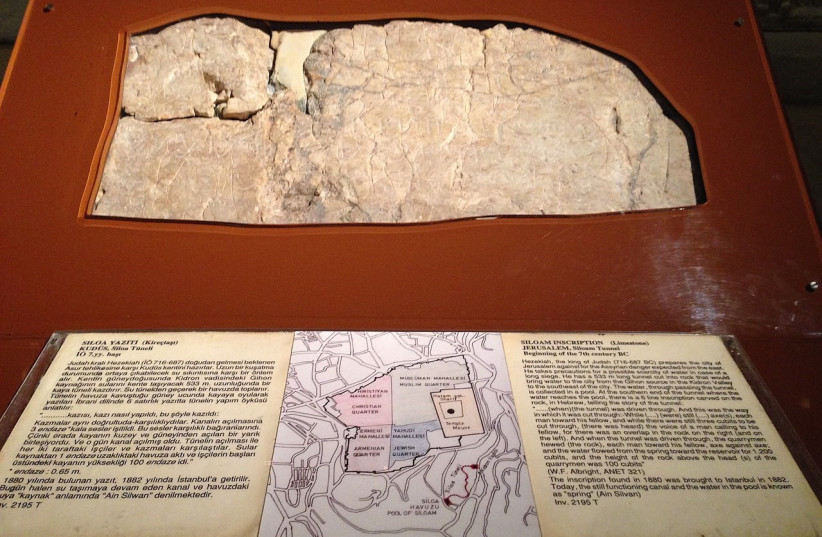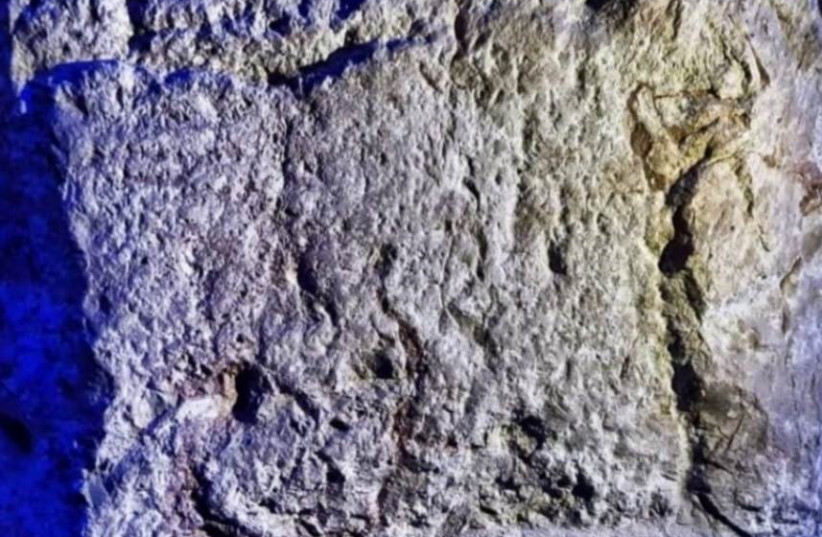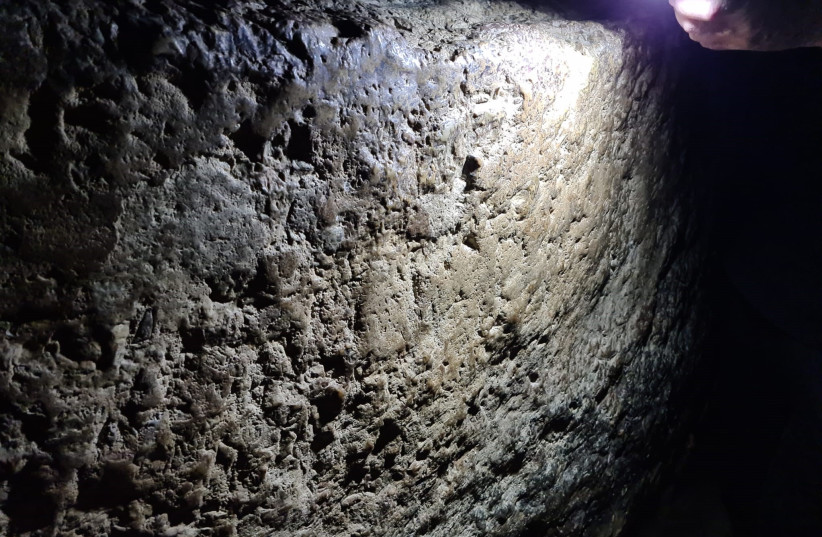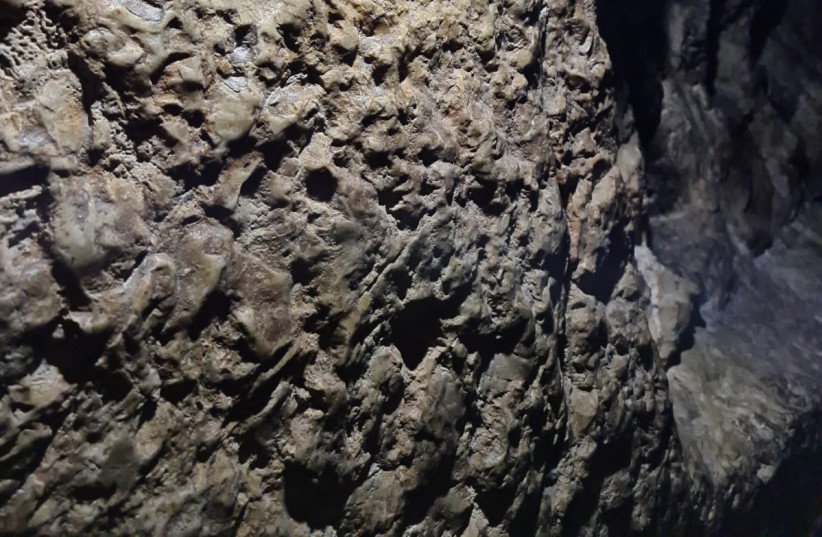by Judy Siegel-Itzkovich
Detailed inscriptions of 8th-century BCE Judean King Hezekiah discovered in ‘monumental’ archaeological discovery.
 |
Summary inscription 1 of King Hezekiah.
(photo credit: Istanbul Archaeological Museum)
|
What a University of Haifa professor of biblical studies and ancient history has called “one of the most important archaeological discoveries in Israel of all time” – five monumental, new royal inscriptions of King Hezekiah of Judah, which together include dozens of lines and hundreds of letters have been deciphered.
Prof. Gershon Galil, a former chairman of the university’s department of Jewish history, said that the inscriptions mention the name of Hezekiah, and summarize his main actions during the first 17 years of his reign, including the water project (the cutting of the Siloam Tunnel and the pool), the ritual reform, the conquest of Philistia and the accumulation of property.
The inscriptions, he maintained, also indicate the exact date on which the water project was completed – 2 Tammuz in the 17th year Hezekiah = 709 BCE. “Now it is clear that the higher chronology that precedes the reign of Hezekiah in 726 BCE is to be preferred, as I emphasize in my book on chronology published in 1996. These are the most complete royal inscriptions we have, and they are further evidence that the kings of Israel and Judah wrote royal inscriptions that indicated their name and deeds," Galil said.
One of the inscriptions was carved into the rock to the right of the entrance to tunnel #4 in the round room of the Canaanite pool next to the Gihon Spring. Exactly 48 centimeters wide and 38 cm long, it is located 140 cm above the floor, the academic explained.
The frame of the inscription was discovered in 1909 by Louis-Hugues Vincent, but he believed that there was no inscription there, but only a frame and a leveled surface prepared for writing an unwritten text, said Galil.
“This is what all the other researchers have claimed for the past 113 years. But recently it turned out that there is an extremely impressive inscription there. Though eroded by time, the vast majority of the letters are legible," he explained.

What does the ancient biblical inscription say?
This is a verbatim quote of the inscription that includes 11 lines, 64 words, and 243 letters:
- Hezekiah, the son of Ahaz, king of Judah,
- made the pool and the conduit.
- In the seventeenth year, in the second (day), in the fourth (month),
- of king Hezekiah, the king brought
- the water into the city by a tunnel, the king led
- the water into the pool. He smote the Philistines
- from Ekron to Gaza and placed there the OREB unit of
- the army of Judah. He braked the images and braked in ˹pieces˺ the Nehu˹sh˺tan
- and he removed the high ˹places and˺ cut down the Asherah. Hezek˹ia˺h, the king,
- accumulated in all his treasure houses and in the house of YHWH
- a lot of silver and gold, perfumes and good ointment.
This “summary inscription,” Galil continued, “is arranged in literary order, not chronologically, and is divided into five components: title, the water project, the wars against Philistia, the reform and the accumulation of property. It includes scriptures that appear verbatim or with slight changes in the Bible, such as: ‘Hezekiah son of Ahaz, king of Judah,’ ‘Make the pool and the conduit,’ ‘brought ... the water into the city,’ ‘smote the Philistines ... as far as Gaza,’ ‘braked the images and braked in pieces the … Nehushtan and he removed the high places and cut down the Asherah… in all his treasure houses and in the house of YHWH, silver ... and gold, perfumes and good ointment’ (see 2 Kings 18: 1, 4, 8; 20: 13, 20).
Eli Shukrun began his work in the City of David over 15 years ago and has since become one of the leading experts on the archaeology of Jerusalem with vast experience based on numerous excavations in the city. Galil said “Shukrun claimed that the frames of some of these inscriptions were known. As mentioned, everyone thought they were empty and were only a preliminary preparation for engraving inscriptions that were never enacted there. But Shukrun believed there were texts there, inside the frames. That’s why he contacted me recently and asked me to re-examine the matter. We both conducted tours of the City of David, walked together in the water inside the Siloam Tunnel and rechecked everything.”
The University of Haifa Bible scholar added that “these are actually the earliest manuscripts of the Bible. They predate the Ketef Hinnom silver amulets - by about 100 years and the Dead Sea Scrolls by hundreds of years. They also support the claim that scriptures in the Book of Kings are based on texts originating from chronicles and royal inscriptions, and that the Bible reflects historical reality and not imagination.”
The Ketef Hinnom scrolls were discovered near the Old City of Jerusalem in 1979 and - until now - were believed to be the oldest surviving texts of the Bible, dating back to about 600 BC, the First Temple period.
“These are actually the earliest manuscripts of the Bible. They predate the Ketef Hinnom silver amulets by about 100 years and the Dead Sea Scrolls by hundreds of years. They also support the claim that scriptures in the Book of Kings are based on texts originating from chronicles and royal inscriptions, and that the Bible reflects historical reality and not imagination.”
Gershon Galil
Galil, who earned his doctorate from the Hebrew University in Jerusalem (HU), previously wrote The Chronology of the Kings of Israel and Judah that suggested a new chronology for the kings of ancient Israel and ancient Judah.
The new inscription he deciphered does not mention the relations with Assyria, the Chaldeans, Egypt, the kingdoms of Transjordan, the activity in Samaria, Hezekiah’s war with the nomads or the fact that the conquests in Philistia were lost in 712 BCE — because in royal inscriptions, only successes are mentioned. These are summary inscriptions, not full descriptions of the king’s deeds, he noted.
“In these new inscriptions, there are answers to many issues that scholars have debated for years. The inscriptions are evidence that Hezekiah carried out a comprehensive reform (before 709 BCE) and even that he conquered Philistia, especially Ekron, and stationed soldiers there (in 712 BCE), as I argued before, and as pointed out in the ‘Azekah inscription.’ Moreover, Hezekiah is indeed the king who built the pool and the Siloam Tunnel and not others. The term ‘oreb’ is mentioned here for the first time, which until now was known only in its Akkadian form: urbi. Now it is clear that it is derived, as Tadmor claims, from the Hebrew term oreb.”
Together, they discovered additional inscriptions. “We took high-quality photos of these ‘frames.’ It soon became clear that there were indeed exciting and surprising texts there. In parallel, we re-examined high-quality photographs of the original Siloam inscription, situated in the Archaeological Museum of Istanbul. There, as well as in the Siloam tunnel, we found other important discoveries.”

Galil checked the Siloam inscription and found that it had additional scriptures, twice as long as what was known until now. It mentions Hezekiah’s name and his main deeds, similar to summary inscription #3.
“It turns out that two more lines are written on the stone found in Istanbul. Moreover, inside the Siloam Tunnel, another five lines survived, below the place where the inscription was carved by robbers and later transported to Istanbul in a clear frame; the bottom line is 70 cm above the tunnel floor, that is, very close to the water. It now becomes clear that the Siloam inscription (summary inscription #1 below) included 13 lines and 428 letters, and not (as previously thought) only six lines and about 200 letters."
The meaning of the discovery is dramatic, Galil declared.

“Parts of the Siloam inscription are found today in the City of David in Jerusalem, inside the Siloam Tunnel; they have simply remained there since the inscription was composed—2,731 years ago.
All the inscriptions will soon be published in Hebrew and English, accompanied by high-quality photographs with detailed linguistic, historical and paleographical discussions, in their forthcoming book: Gershon Galil and Eli Shukrun, The Inscriptions of Hezekiah King of Judah, which was accepted for publication, and will be published in the coming year.
Judy Siegel-Itzkovich
Source: https://www.jpost.com/archaeology/article-725074
No comments:
Post a Comment